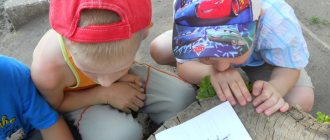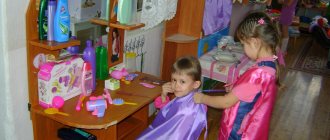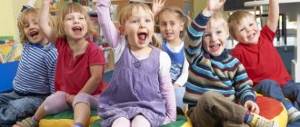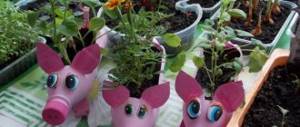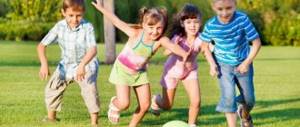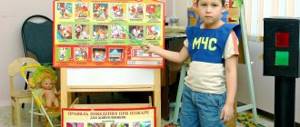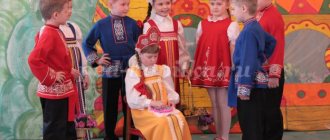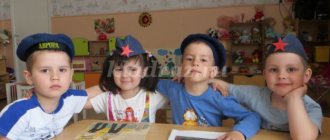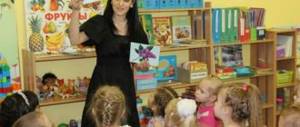Short-term project of the second junior group “Observation of a living object - a cat”
Larisa Sozonova
Short-term project of the second junior group “Observation of a living object - a cat”
Relevance of the project :
"Do no harm!"
- one of the commandments of human communication with nature.
Raising young preschoolers in the spirit of environmental conservation is one of the aspects of environmental education in kindergarten. Love, understanding and care are what nature expects from every person. It is advisable to begin to cultivate these feelings in early childhood. Communication with animals, if it occurs uncontrollably, can bring not only benefits, but also harm to the developing personality of the child. A child’s attitude towards an animal and his purposeful action may turn out to be incorrect for a number of reasons. First of all, the child does not know what can be done and what cannot be done, what is harmful for the animal and what is beneficial. In addition, in close contact with an animal, the baby will want to satisfy his curiosity and involve him in the game. Without adult supervision and guidance, such communication can be harmful and even dangerous for both the animal and the child. Observations of the children in my group and preliminary diagnostics showed that the problem in children’s communication with pets is an insufficient level of knowledge about pets, ignorance of the rules for caring for and keeping pets.
Children 3 years old are trusting and spontaneous, easily involved in practical activities together with adults, and enjoy manipulating various objects. The formation of the initial foundations of ecological culture is the accumulation of specific, sensory ideas about objects and natural phenomena. Surrounding kids. An important aspect of environmental education at this age stage is the formation of children’s understanding of the specifics of a living object , its fundamental difference from the object. An indicator of environmental education is manifested at this age only in the voluntary and active participation of children in joint activities with adults. Such activities should be colored by the children’s positive emotions.
In order for this project to be interesting for children and leave vivid impressions in their memory, parents were involved in the implementation of the project , who helped provide mini- projects about their favorite pets, living objects : we observed a cat with kittens on the territory of the kindergarten. Communication with living objects always brings joy to children and remains in the children’s memory for a long time.
Goal: to develop an interested, caring attitude towards pets by generalizing and expanding knowledge about the pet – the cat .
Objectives: to create conditions for the formation of cognitive interest in children about the structure, habits, habits of cats ;
— to develop children’s knowledge about domestic animals;
- give an idea of the needs of animals for their growth and development;
— to cultivate feelings of empathy for all living things, the ability to make basic conclusions and conclusions.
Type of project : educational - research.
duration – short-term (from 07/01/2016 – 11/01/2016)
participants - children , teachers, parents.
Age group – second junior group .
Work to implement the project was carried out in several stages.
Organizational stage.
At this stage, a survey of parents was conducted with the aim of: finding out the attitude of parents towards pets, keeping them at home, how parents instill a love for animals in their children. The results of the questionnaire showed that most parents love pets; many had pets at home in childhood, and this left a good, kind impression. Almost all parents believe that it is necessary to cultivate a love for animals from an early age. However, many parents do not want to keep animals at home and do not pay attention to fostering love for animals and respect for them.
Primary work was carried out with the children to identify the level of general knowledge and ideas about domestic animals, the conditions of their maintenance and nutrition. The results on this issue showed that some children have an insufficient level of knowledge.
To implement the project, the necessary literature was selected (songs, nursery rhymes: “Kitsonka - Murysonka”
,
“The cat went to the stove”
,
“Cat - cat”
, N. Nosov
“Who said meow”
,
“
Cat’s House ” , joint mini-
projects of parents and children “My favorite pet is
a cat ” , audio recordings with animal voices were selected , board games were selected: lotto
“Pets”
,
an exhibition of books with pets – cats the group , and a mini-museum of toys – cats was also organized.
Productive stage.
to implement the project .
Long-term plan:
1. GCD “The cat came to visit us ”
2. Looking at the painting “ Cat with Kittens ”
.Goal: to clarify ideas about domestic animals, to introduce
cats , to teach how to identify features of appearance, to introduce features of behavior, to consolidate features of the appearance and behavior of cats and kittens .
Fiction
1.Reading: “Who Said Meow”
,
«cat house»
.
2. Memorizing the poem “Like our cat”
,
"Pussy, pussy"
.
Artistic creativity
1. Application made of cotton pads and threads; made of paper (assembling a cat from separate parts )
.
2. Drawing kittens. Goal: learn to paint over the image of a kitten with pencils, induce a joyful mood.
Invite parents and their child to create a mini- project about their pet, a cat .
Cognition
1. Observation of a cat and kitten.
2. Research activity “Kitten nutrition”
.
Physical development
1. Teach children the outdoor games “Sparrows and the Cat”
,
"Cat and Mice"
.
Goal: to develop the ability to act on a signal.
Musical development
1. Listening to an audio recording with the voices of pets, learning a song about a cat “Grey Kitty”
.
Invite parents to repeat the song with their children .
Play activity
Didactic games:
"Who lives where?"
,
“Where is whose house?”
, lotto
"Pets"
.
Presentation stage:
— Exhibition of children's works - cats made from different materials (applique)
- Exhibition of children's works - kittens (drawing: painting)
— Exhibition of joint mini- projects “My favorite pet is a cat (parents and children)
.
The final stage: summing up the project .
At the final stage of the project, the results were summed up and identification work was carried out, which showed positive results (increase in high and medium level indicators)
.
Considering that the project is short-term and thematic , the following criteria were chosen:
all children:
- recognizes and shows several pets;
- show who lives where;
— tell what a cat and a kitten ;
— can explain how to treat a cat .
After working with children and parents, Syomka Veronica’s family decided to get a British breed cat !
Lesson notes for the second junior group
“The cat came to visit us ”
